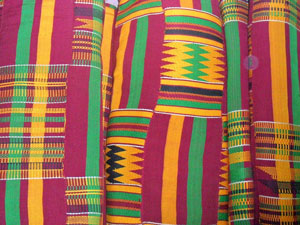Emergence of Color in Kente
When the cloth was presented to the Ashanti king, he was extremely impressed with it. Still, he believed it would be even more extraordinary if it were woven with many different colors. Since the raffia tree only produced black and white thread, the weavers needed to come up with a new way of creating colorful threads. Akwasi Opoku-Agyeman, one of the greatest weavers, came up with the idea of using the bark and seeds of local trees to create dye. Weavers would shave the bark from trees, grind their seeds, and then pound both together to produce dyes. There were different trees that created red, green, and yellow dyes, which is why these are the traditional kente colors. The threads would then be soaked in the dye and woven together to create colorful fabrics for the king.
According to Ashanti tradition,
- Black represents Africa
- Red represents the blood of forefathers
- Yellow represents gold
- Green represents the forest
The first colorful kente cloth was worn by Otumfuo Nana Prempeh I, a former Ashanti king, and was named Oyokoman after the clan to which he belonged.

